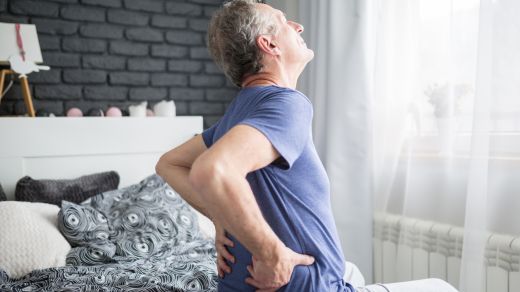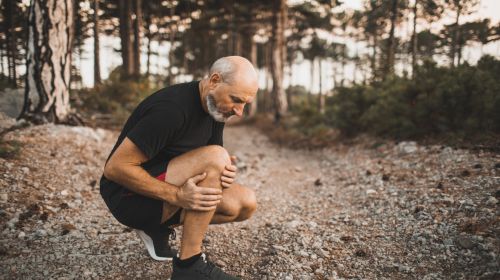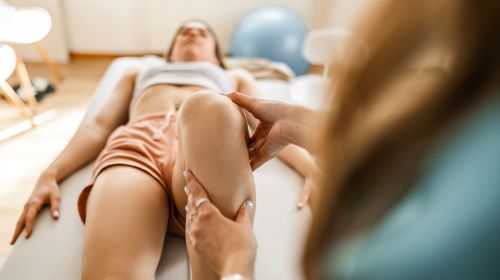Spondyloarthrosis (also known as facet syndrome) often affects the lumbar spine (lumbar spine). This causes the articular cartilage of the small facet joints, which connect the vertebral bodies of the spine, to wear away. The result is often severe back pain, which can lead to occupational disability. Which therapy helps?
- © Getty Images/InnerVisionPRO
Quick overview: Spondylarthrosis
definition: Spondyloarthrosis leads to wear and tear on the joints in the vertebrae, which are located at the back of the vertebral arches (facet joints).
Symptoms: Typically there is severe back pain that can radiate to other areas of the body.
causes: The most common trigger is joint wear and tear caused by increasing age. There are also risk factors such as frequent incorrect and overloading of the spine.
therapy: Therapeutic measures include painkillers, physiotherapy and back training. Surgery may only be indicated in certain cases.
At a glance:
Spondyloarthrosis often affects the lumbar spine
Over the course of life, bones and joints show signs of wear and tear, which are part of the natural aging process. In spondyloarthrosis, the small vertebral joints on the back of the vertebral arches, the so-called facet joints, wear out.
The wear and tear disease has a few other names:
- facet joint arthrosis,
- Osteoarthritis of the vertebral joint or
- Facet syndrome.
In principle, the disease can occur in all areas of the spine. The vertebrae of the joints usually wear out in regions that are exposed to particular stress. This applies, for example, to the entire lumbar spine (lumbar spine). The degradation processes in the thoracic or cervical spine (thoracic spine, cervical spine) are less common.
Spondyloarthrosis predominantly affects people older than 40 years, although there are no exact figures on the frequency.
Symptoms of spondylarthrosis
Spinal joint arthrosis can have a variety of symptoms. Back pain that feels dull or stabbing is typical. They often cannot be precisely localized because they radiate to other areas of the body.
The location of the pain depends on which area of the spine is affected. The lumbar spine is usually exposed to particular stress. With spondyloarthrosis of the lumbar spine, those affected often experience back pain that radiates to the leg, buttocks or groin.
When the facet joints in the thoracic spine wear, the pain is more noticeable in the upper body. If the cervical spine is affected, neck pain occurs, which often extends into the
- Poor,
- hands and
- Radiate fingers.
The pain usually increases with physical activity such as sports because the spine is put under greater strain. When you are in a resting position, the pain often subsides again.
Those affected are also significantly restricted in their ability to move. They find it difficult to bend over or lean to the side. The spine becomes immobile and stiff.
The intensity of the pain depends on the individual and usually says nothing about the severity of the spondyloarthrosis. Minimal degenerative changes can cause severe pain, while major signs of wear sometimes cause only a few symptoms.
Symptoms of advanced spondyloarthrosis
As facet joint arthrosis progresses, the following symptoms may arise or worsen:
Painful muscle hardening and muscle tension can occur because the spine loses its stability and significant tensile forces act on the ligaments and muscle attachments.
Tingling, numbness, paralysis: such neurological symptoms occur when bony protrusions form; These narrow the holes through which the nerve roots pass – the nerves come under increasing pressure.
The pain and inflammation continue to increase.
Spondylarthrosis: causes and risk factors
The most important causes include age-related wear and tear. In addition, there are other risk factors for vertebral joint arthrosis. These include:
- Incorrect loading and overloading of the spine
- Sports that put strain on the spine and vertebral joints, such as weight lifting
- Wear and tear on the intervertebral discs: Their height decreases, which leads to overloading of the vertebral joints
- Herniated disc (disc prolapse)
- Scoliosis: the spine is bent and twisted
- Hyperlordosis: the spine is curved convexly
- Hollow back
- inflammatory diseases such as rheumatoid arthritis (“rheumatism”)
- Bone loss (osteoporosis)
- tumors
- Overweight and obesity (obesity)
- weak abdominal and back muscles
As a result of overloading, bony outgrowths sometimes form to counteract the increasing instability of the spine. However, these ossifications severely limit the mobility of the spine.
Treatment of spondyloarthrosis
In many cases, back pain due to spondyloarthrosis can be treated conservatively, i.e. without surgery. Different methods are usually combined to relieve the pain. Which therapies are suitable depends on the intensity of the pain.
Treatment measures include:
Painkiller: Anti-inflammatory pain medications, such as ibuprofen, provide relief. Alternatively, the doctor injects the painkiller directly into the site of pain (next to the vertebra or into the facet joint).
Muscle relaxing medications (muscle relaxants): The medicines loosen the muscles and relieve tension.
physical therapy: Passive exercises in which the physiotherapist moves certain parts of the body are helpful. The exercises improve mobility and strengthen and stretch the muscles.
Massages loosen tense muscles and help with muscle stiffness.
Back trainingto strengthen the back muscles with targeted exercises. Strong muscles relieve the strain on the spine and counteract back pain.
Physical therapysuch as electrotherapy, heat, cold and balneotherapy (bath treatments) alleviate the symptoms.
Spondyloarthrosis surgery: when does it make sense?
Surgery is an option if those affected suffer from severe pain despite conservative treatment or if it cannot be adequately relieved.
One possibility is to destroy the pain fibers of the affected joint capsule electrosurgically. If there is massive signs of wear and tear and instability or restricted movement of the spine, stiffening (spondylodesis) of the affected region may be recommended.
In general, however, surgical intervention is only an option for a few patients because the degenerative changes are often too advanced.
Diagnosis of spondyloarthrosis using a pain questionnaire
If you have severe and recurring back pain, those affected can first seek advice from their family doctor, where they may be referred to an orthopedic practice.
In an anamnesis conversation, complaints and medical history are queried. A standardized pain questionnaire is usually used to record the intensity, location and duration of the pain more precisely.
This is followed by a physical examination in which the aim is to locate particularly painful points and to narrow down the locations of the pain more precisely. Muscle hardening can also be felt in this way. In addition, the function of the joints, mobility and gait are checked.
As a supplement, experts use imaging procedures, such as:
Spondylarthrosis: course and prognosis
The wear and tear disease cannot be cured because the damaged joint cartilage no longer regenerates and does not grow back. But the symptoms of vertebral joint syndrome can be alleviated and the progression of spondyloarthrosis can be slowed down.
Regular exercise, physical therapy, and a healthy weight will help prevent facet joint syndrome from getting worse. Many of those affected can live a daily life with little pain and their quality of life improves significantly.



